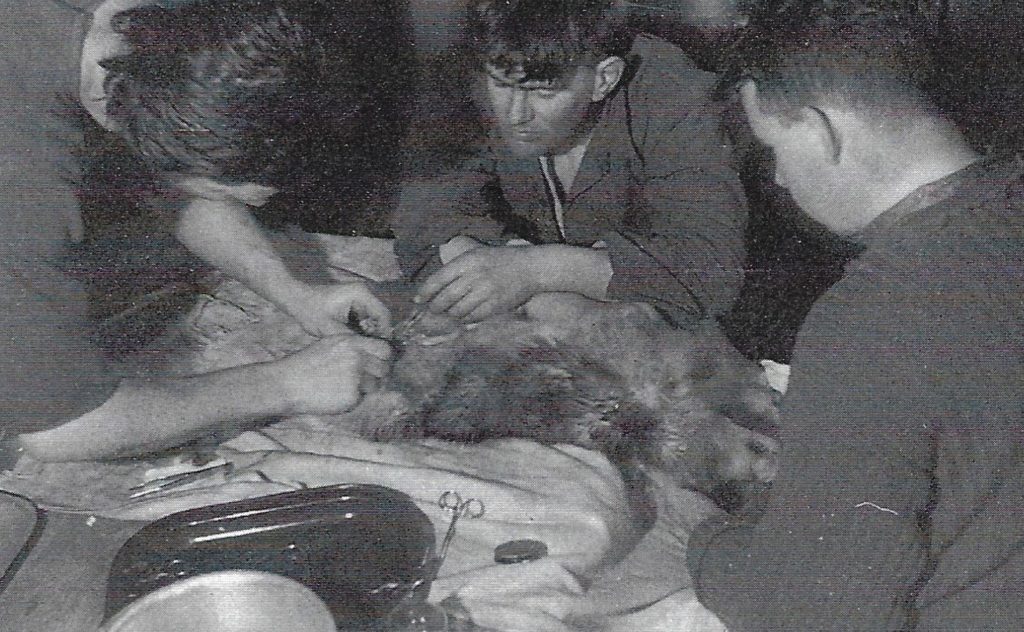A typical day at Base E, 1946/7 (continued)
Cooking was done in rotation on a slow burning solid fuel stove; no specialist cooks were carried and some weeks were better than others!
Water came from snow or ice melted in a tank that was close alongside the cooking stove; it was topped up as necessary with a box of ice chippings excavated from a particular iceberg. There was very little privacy and it was understood that anyone lying in their bunk was “out of circulation” and not expected to answer questions – unless they indicated otherwise.
Apart from the cook, where everyone did a week’s stint in turn, duties for running the base were shared without any form of “duty list”.
Picture a mid-morning tea break in early spring. Six of the party had only recently come back to base after a 3 week depot laying trip to the Plateau where they have left 2 tons of food, for men and dogs, that would be needed for an 8 week journey that was planned to start in a week’s time. These were the days before depots were established by aircraft. The sun had returned after its midwinter absence and 3 of the group had just come back into the hut after a visit to the dogs. One man is sewing, one is drawing out some survey sheets, the doctor is writing up some notes about a dog that had undergone an operation 3 days earlier and was recovering well. The duty cook comes in with a large teapot and a tray of scones that he had made from a new recipe and tells the assembled company that the water tank is in need of a refill. The wireless operator had just finished the morning schedule with The Falkland Islands and had two personal telegrams to pass on.


Someone who wanted an excuse to exercise his dog team offered to collect the ice “if someone will give me a hand with my team”. The last person comes in from feeding the three week old pups and is carrying one that has been attacked by a jealous bitch who had climbed out of her pen. The pup was handed to the doctor for an immediate consultation. As an afterthought the newly-arrived person announces that there is a seal on the ice to be collected. The ice collector agrees to collect the seal and drag the carcass back behind the sledge, but will need help to do so.
While all this is going on a discussion is going on about the names to be given to the new pups – naming of new pups is always a topic of lively debate and discussion can become quite heated!!
The hut partially empties and an hour later the front door is flung open, a large box of ice chippings if brought in for the water tank and in addition to that, there is some very fresh seal kidney.
Outside, bedlam breaks out as the dogs have spotted someone approaching the seal pile with the new seal carcass and hopefully that means feeding time. In fact, they are wrong for the dogs are always fed late in the afternoon.
Mid-day lunch does not take long for daylight hours are short and by the time the dogs are fed and all the work outside is finished it is dark.
The paraffin pressure lamps are lit and soon everyone is back in the hut for the evening. Supper was always a bit more formal than the rather rushed midday lunch. A table cloth is always spread, working clothes have been changed out of, the meal was properly served in serving dishes and no open tins were allowed on the table. Washing up was regarded as a social occasion; the washing up bowl was brought to the table, together with a tray, a draining rack and dishcloths and everyone was invited to take part. As a matter of principle the cook of the day played no part in the washing up apart from ensuring there was enough hot water. The chess board might be brought out, or cards for a game of Bridge. There was only a hand-wound gramophone to provide music and the rule was that if at any time a majority of people on based turned against a particular record it could be destroyed – this discouraged people from playing anything too often!
The person whose turn it is for a bath will have been heating some water on the workshop stove; the Victorian tin bath will be brought down from the stowage in the ceiling and as the bather dries himself he will be washing his clothes by stamping on them in the used bathwater. By ten at night the lights will have been doused and most people will have retired to bed to read. A scene such as this is repeated with variations many time over. Sometimes it will be blowing a full “fumigator” with wind speeds up to 70mph and people in the hut will be glancing up at the wind speed indicator mounted on the wall, wondering if the needle will would push the maximum mark higher than ever before. In high winds, snow will build up round the hut and dogs outside may be buried; on other days it will be wonderfully sunny without a cloud in the sky. At a base with dogs there is always work to do and no matter what the weather or your own mood there is always a welcome from the dogs outside.
Described in this way the “quality” of life may appear to be low. In fact it was far from it; it was certainly simple and uncomplicated and living so close together could well have led to many clashes of personalities. With FIDS and BAS this only happened very rarely. All of us who have lived and worked in Antarctica know that the catalyst that helped things work as well as they did was the presence of the dogs on whom we completely relied.
